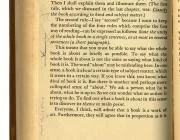How to Read a Book
“Everyone, I think, will admit that a book is a work of art.” —Mortimer J. Adler, How to Read a Book,
PN 83.a43 1940 mn
“Not this one” —marginalia
Oh snap.
All books may not be art, but they are books. The look of them. The feel of them: just paper in the hands & your hands moving through its odd habitual itinerary. Some readers check off chapters, tick off each paragraph as read, done, and over, over and over, just to be sure, hence the check marks in the margins of this copy. What am I sure of? Doves diving by the library window in search of something unknowable, then looping back again. The afternoon light through a wintry drear? The sudden attempt at focus of the students studying for finals, December, late afternoon, a Wednesday, every carrel suddenly, improbably in use? The cellular trill that interrupts the gaze? Reminders that conversations—flattened into data—are in the air around us even if we cannot receive them? The ways we try to pay attention to what we know we ought but rarely can?
Our attempts at love come back to mind every other moment: how have we failed, and when did we know, and why does it come back to the brain like this? “To say what the whole book is about is not the same as saying what kind of book it is. The word ‘about’ may be misleading here,” says Adler. But about is everything, a cup for collecting, a magnet gathering data from everywhere we can imagine into essay.
Every afternoon has a terror in it, opportunities for error, the hum of fair air through the ventilating shafts that terminate in slatted squares and spread our breath flat out across the floor. Everyone is breathing us. We are mouth to mouth, a study in resuscitation, the collective dioxide heft leftover from our brains’ effort. Then someone farts. A giggle.
The margin note is a spark of snark, the reader irritated enough to inscribe the space, not just with check marks and asterisks, glyphs of the age of type, the type of age we’re in where a student asks me what font was the Declaration of Independence written in? And I say Comic Sans, sans wink or hint of anything but the epic fount of knowledge that I periodically tap on command and pour out, pearls overflowing in the hand. It was cheap, an easy out. I don’t feel good about it.
Dear undergraduate, let me tell you about rage: the defacing of the pages in the university library makes me want to get my box cutter and rain terrorism on your wee, thonged heart. I am all for marginalia, and Adler argues for this, but save it for a book you own or wrote or at least hope to fill with interesting argument, your breath now alive with mint. Yes, I see you with the Altoid tins, the sugar stink, the price we pay for trying to think so hard for so long that everything is like like, pairable, easily associated, in comparison with another, slotted in a tube of convergence until it comes together or fails into obsolescence or meaninglessness. “Together” is a useful illusion, the artifice of the vanishing point. Nothing really ever comes together. Not us and those we love, I fear. We are on separate rails, magnetically opposed.
Some days I feel closed to the new, curled up in myself like an @, in Italian it’s called chiocciola, curled snail. Where are we @ exactly? I mean it in the contemporary way, like are we here, shelved, libraried, haunted by thoughts of X and how she looked alone in libraries, caught in the trap of fantasy, or are we somewhere else instead, overhearing a break-up conversation, voicemail breaking up a carrel away, a generation away, a life away in dream already, on the verge of vanishing or already gone?

